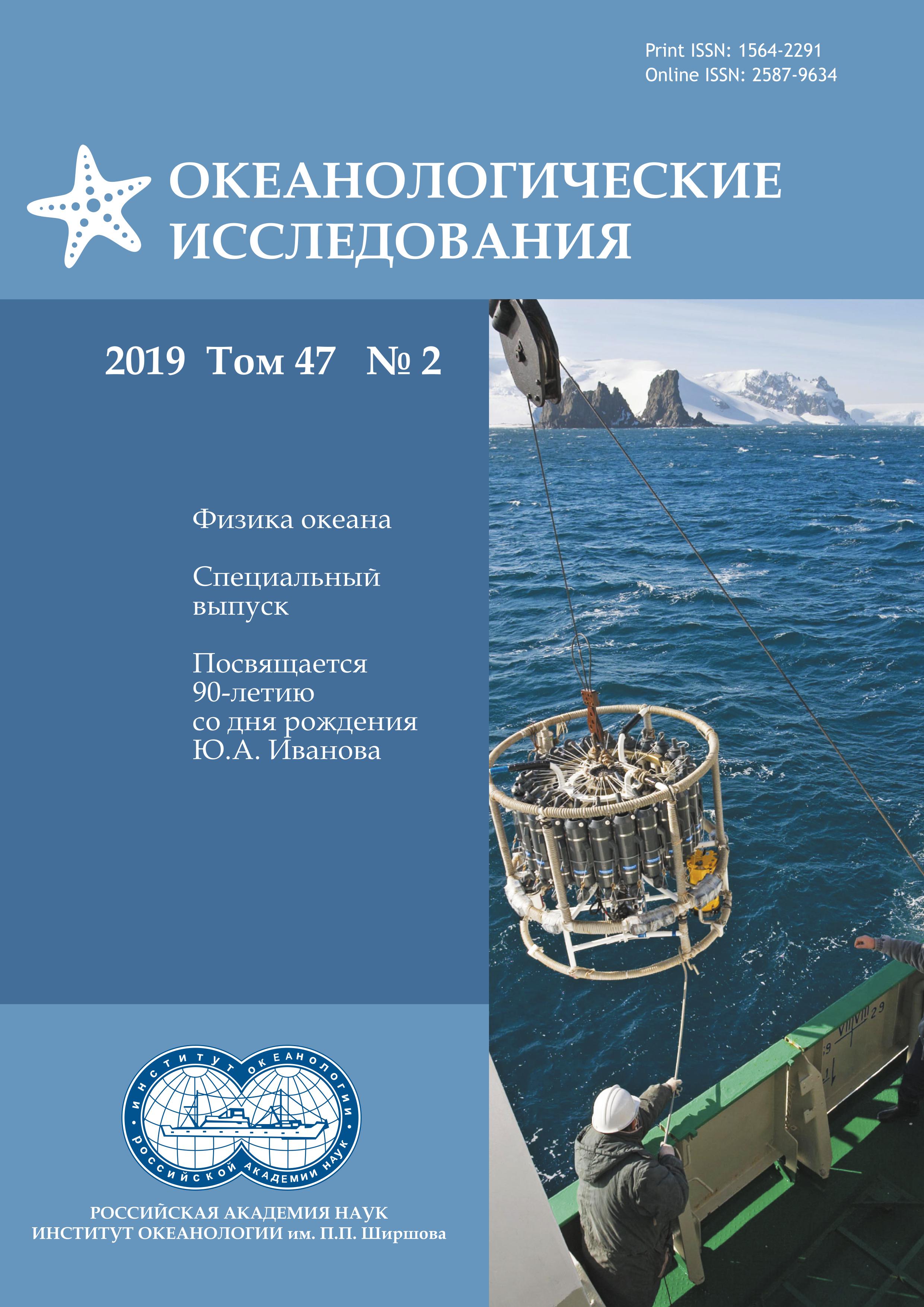О СТРУКТУРЕ СЕВЕРО-АТЛАНТИЧЕСКОГО ТЕЧЕНИЯ В МАЕ–ИЮНЕ 1990 г.
Аннотация
В рамках отечественного проекта «Разрезы», включенного в международную программу WOCE, в 1990 г. были выполнены комплексные гидрофизические исследования Ньюфаундлендской энергоактивной зоны, в которых приняли участие научно исследовательские суда (НИС) Института океанологии им. П.П. Ширшова «Витязь» (19-й рейс), «Профессор Штокман» (26-й рейс) и «Академик Курчатов» (50-й рейс) и 4 судна других ведомств. Научное руководство общей программой работ экспедиции, получившей название “Атлантэкс-90”, осуществлял профессор Ю.А. Иванов. В качестве основной задачи программа предусматривала исследование пространственновременной короткопериодной изменчивости динамики вод крупномасштабной системы Гольфстрим-Северо-Атлантическое течение. С этой целью в мае-июне 1990 г. НИС «Академик Курчатов» выполнил несколько разрезов, пересекающих главные гидрологические фронты Ньюфаундлендской энергоактивной зоны (45–53°с.ш., 36–45°з.д.). Наблюдения велись с помощью кабельных зондов с датчиками температуры, электропроводности и давления (СТД) и обрывных зондирующих устройств (теряемый батитермограф-ТБТ). Вся эта аппаратура в виде малых серий была изготовлена и прошла метрологическую аттестацию в ОКБ Океанологической техники ИОАН СССР. Вдоль всего маршрута НИС проводились наблюдения температуры поверхности океана (ТПО). На разрезе от 47° до 53°с.ш. вдоль меридиана 36°з.д. в продолжение около одного месяца велись измерения скорости течений на 14 заякоренных буйковых станциях с помощью приборов марки ПОТОК производства ОКБ ОТ ИОАН, установленных на горизонтах 100, 200, 1000, 2000, 3500 м. В дополнение к данным собственных измерений в течение всего периода наблюдений по радиоканалу связи принимались факсимильные карты ТПО из ближайших гидрометеорологических обсерваторий.
Анализ полученных данных показал, что за период наблюдений Северо- Атлантическое течение (САТ) разделялось на две ветви (Центральную и Южную) примерно в окрестности 47,5–48°с.ш., где изобата 4500 м поворачивала на восток под прямым углом к изобате 4000 м. После точки бифуркации Центральная ветвь вначале сохраняла северное направление, затем поворачивала на северо-запад вдоль изобаты 4000 м, и далее, разворачиваясь на восток, пересекала меридиан 36°з.д. между 51° и 52°с.ш. Перед этим, временами Центральная ветвь приближалась к меридиану 36°з.д. около 50°с.ш., затем отклонялась на север, северо-запад и, наконец, поворачивала на северо-восток около 51,5°с.ш. Южная ветвь САТ после раздвоения потока следовала приблизительно изобате 4500 м и пересекала меридиан 36°з.д. около 48°с.ш. К востоку от 36°з.д. она временами могла иметь восточное, северо-восточное направление, но обычно разворачивалась на юг, юго-запад, формируя высокий гребень динамической высоты поверхности океана на восточном фланге САТ. Три возвратных потока наблюдались на разрезе по 36°з.д. Один из потоков отмечен между Центральной и Южной ветвями САТ, а два других были зарегистрированы на северном и южном краях разреза. Такая структура поля скорости фактически сохранялась неизменной в течение июня 1990г. Основные зональные потоки наблюдались практически во всей водной толще в слое от 100 м до 3500 м. Самые высокие скорости были характерны для верхней части этого слоя. На глубинах 1000–2000 м скорости заметно ослабевали, вновь несколько возрастая в отдельных местах у дна. Распределение меридиональной компоненты скорости течения по данным измерений на буях позволило обнаружить наличие крупномасштабной дивергенции, располагавшейся вдоль разреза по 36° з.д. К северу и к югу от широты около 49° направления меридиональных компонент скорости течений оказались противоположными, что характерно для расходящихся потоков, формирующих дивергенцию в поле скорости течений. При анализе материалов наблюдений было обращено внимание на то, что важную роль в формировании структуры циркуляции океана в районе исследований могла играть подводная гора (~2600 м), зарегистрированная эхолотами НИС «Академик Курчатов» вблизи 49°с.ш., 36°з.д. Результаты измерений и расчетов показали, что средний за весь период наблюдений перенос Центральной ветви САТ через 36°з.д. составлял 62,4 Св. Эта величина сопоставима с переносом САТ, оцененным четырьмя годами позже Лазиером (1994) 50±23 Св. примерно для того же района, где проводились наши работы в 1990 г. Приблизительно такой же средний перенос (46,5 Св.) осуществлялся двумя возвратными потоками (предположительно Северной и Южной рециркуляциями Южной ветви САТ). В целом средний перенос вод в восточном направлении через разрез по 36°з.д. достигал 111 Св., а после вычитания обратных потоков составил 60,9 Св.
Литература
- Баранов Е.И. Структура и динамика вод системы Гольфстрима. М.: Гидрометеоиздат, 1988. 252 с.
- Баранов Е.И., Гинкул В.Г. Динамика вод Ньюфаундлендской энергоактивной зоны // Метеорология и гидрология. 1984. № 12. С. 78–84.
- Барышевская Г.И. Течения системы Гольфстрима и температурный режим Северной Атлантики. М.: Гидрометеоиздат, 1990. 139 с.
- Барышевская Г.И. Изменчивость расхода в центральной части Северо-Атлантического течения // Метеорология и гидрология. 1985. № 2. С. 77–87.
- Бубнов В.А. Северо-Атлантическое течение по данным эксперимента “Атлантекс-90” // Океанология. 1994. Т. 34. № 6. С. 805–809.
- Бышев В.И. О некоторых особенностях внутритермоклинной линзы на субполярном фронте в Северной Атлантике // Океанология. 1992. Т. 32. С. 1012–1018.
- Бышев В.И., Копрова Л.И., Навроцкая С.Е., Позднякова Т.Г., Романов Ю.А. Аномальное состояние Ньюфаундлендской энергоактивной зоны в 1990 г. // ДАН. 1993. Т. 331. № 6. С. 735–738.
- Бышев В.И., Копрова Л.И., Романов Ю.А. О формировании аномалий температуры поверхности океана в районе Ньюфаундлендской энергоактивной зоны в мае-июне 1990 г. // Метеорология и гидрология. 1996. № 7. С. 78–88.
- Гладышев В.С., Соков А.В., Гулев С.К., Паутова Л.А., Демидов А.Б. Среднемноголетняя структура и перенос вод системой западных пограничных течений восточнее Гренландии // ДАН. 2017. Т. 473. № 1. С. 93–97.
- Гулёв С.К., Иванов Ю.А., Колинко А.В., Лаппо С.С., Морозов Е.Г. Эксперимент “Атлантекс-90” // Метеорология и гидрология. 1992. № 5. С. 51–61.
- Иванов Ю.А., Морозов Е.Г. Перенос вод в дельте Гольфстрима // ДАН. 1991. Т. 319. № 2. С. 487–490.
- Копрова Л.И., Романов Ю.А. О горизонтальной структуре термических фронтов Северо-Атлантического течения на поверхности океана // Метеорология и гидрология. 1993. № 4. С. 76–84.
- Международный геолого-геофизический атлас Атлантического океана. (под ред. Г.Б. Удинцева). М.: 1989–1990 гг. 158 с.
- Романов Ю.А., Позднякова Т.Г., Филиппов И.А. О факсимильных картах ТПО Северной Атлантики // Метеорология и гидрология. 1991. № 12. С. 92–95.
- Arhan M. The North Atlantic Current and Subarctic Intermediate Water // J. Mar. Res. 1990. Vol. 48. No. 1. P. 109–144.
- Arhan M., Colin de Verdier A., Mercier H. Direct Observation of the Mean Circulation at 48° N in the Atlantic Ocean // J. Phys. Oceanogr. 1989. Vol. 19. No. 2. P. 161–181.
- Chuan Shi, Shenn-Yu Chao. Eastward Jets over Diverging Isobath with Applications to the Gulf Stream past the Grand Banks // J. Geophys. Res. 1994. Vol. 99(C11). P. 22689–22706.
- Clarke R.A., Hill H., Reneger R.F., Warren B.A. Current System South and East of the Grand Banks of Newfoundland // J. Phys. Oceanogr. 1980. Vol. 10(l). P. 25–65.
- Dietrich G., Kalle K., Krauss W., Sidler G. General Oceanography. New York: John Wiley, 1975. 626 p.
- Fahrbarch E., Warge G. Observations of the Persistent Pattern in the Temperature Field Related to the North Atlantic Current // Dtsch. Hydrogr. Z. 1987. Vol. 40(4). P. 141–155.
- Gana S., Provost C. Circulation and Fluxes of the Central North Atlantic in 1983/1984 Estimated by Inverse Analysis of TOPOGULF Hydrographic Data // J. Mar. Syst. 1993. No. 4. P. 67–92.
- Hardtke P.G., Meincke J. Kinematical Interpretation of Infrared Surface Pattern in the North Atlantic // Oceanol. Acta. 1984. Vol. 7(3). P. 373–378
- Heywood K.J., McDonagh E.L., White M.A. Eddy Kinetic Energy of the North Atlantic Subpolar Gyre from Satellite Altimetry // J. Geophys. Res. 1994. Vol. 99(Cl l). P. 22525–22539.
- Krauss W. The North Atlantic Current // J. Geoph. Res. 1986. Vol. 91(C4). P. 5061–5074.
- Krauss W., Fahrbach E., Aitsam A., Elken J., Koske P. The North Atlantic Current and its Associated Eddy Field SouthEast of Flemish Cap // Deep-Sea Res. 1987. Vol. 34(7). P. 1163–1183.
- Krauss W., Kase R.N., Hinrichsen H.H. The Branching of the Gulf Stream SouthEast of the Grand Banks // J. Geophys. Res. 1990. Vol. 95(C8). P. 13089–13103.
- Lasier J.R.N. Observations in the Northwest Corner of the North Atlantic Current // J. Phys. Oceanogr. 1994. Vol. 24(7). P. 1449–1463.
- Leach H. Interannual Variability in the Upper Ocean in the North Atlantic, Summer 1983 and 1986 // Deep-Sea Res. Part A. 1990. Vol. 37(7). P. 1169–1176.
- Leach H. The Analysis of Currents Measurements from a Moving Ship in the North Atlantic Polar Front // Deep-Sea Res. 1986. Vol. 33(8). P. 1069–1081.
- Mann C.R. A Review of Branching of the Gulf Stream System // Proceedings of the Royal Society of Edinburgh: Set. B. Biol. Sci. 1972. Vol. 72. P. 341–349.
- Mann C.R. The Termination of the Gulf Stream and the Beginning of the North Atlantic Current // Deep-Sea Res. 1967. Vol. 14(3) P. 337–358.
- McCartney M.S., Talley L.D. The Subpolar Mode Water of the North Atlantic Ocean // J. Phys. Oceanogr. 1982. Vol. 12(12). P. 1169–1188.
- Stommel H., Niiler P., Anati D. Dynamic Topography and Recirculation of the North Atlantic // J. Mar. Res., 1978, Vol. 36(3), pp. 449–468
- Sy A. Investigation of Large Scale Circulation Patterns in the Central North Atlantic: The North Atlantic Current, the Azores Current, and the Mediterranean Water Plume in the Area of the Mid-Atlantic Ridge // Deep-Sea Res. Part A. 1988. Vol. 35(3). P. 383–413.
- Sy A., Schauer U., Meincke J. The North Atlantic Current and its Associated Hydrographic Structure above and Eastward of the Mid-Atlantic Ridge // Deep-Sea Res. Part A. 1992. Vol. 39. P. 825–853.
- Warren B. Divergence of Isobath as a Cause of Current Branching // Deep-Sea Res. Suppl. to 16. 1969. P. 339–355.
- Worthington L.V. On the North Atlantic Circulation // Oceanographic Studies. 1976. Vol. 6. P. 1–110.
Передача авторских прав происходит на основании лицензионного договора между Автором и Федеральным государственным бюджетным учреждением науки Институт океанологии им. П.П. Ширшова Российской академии наук (ИО РАН)













